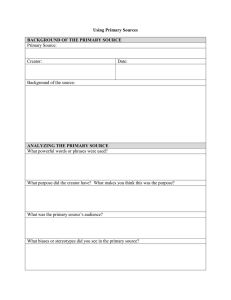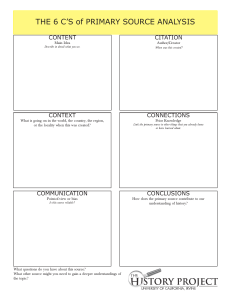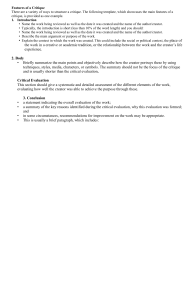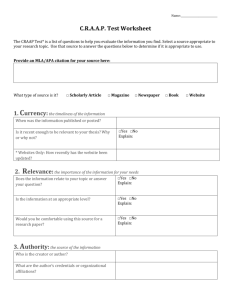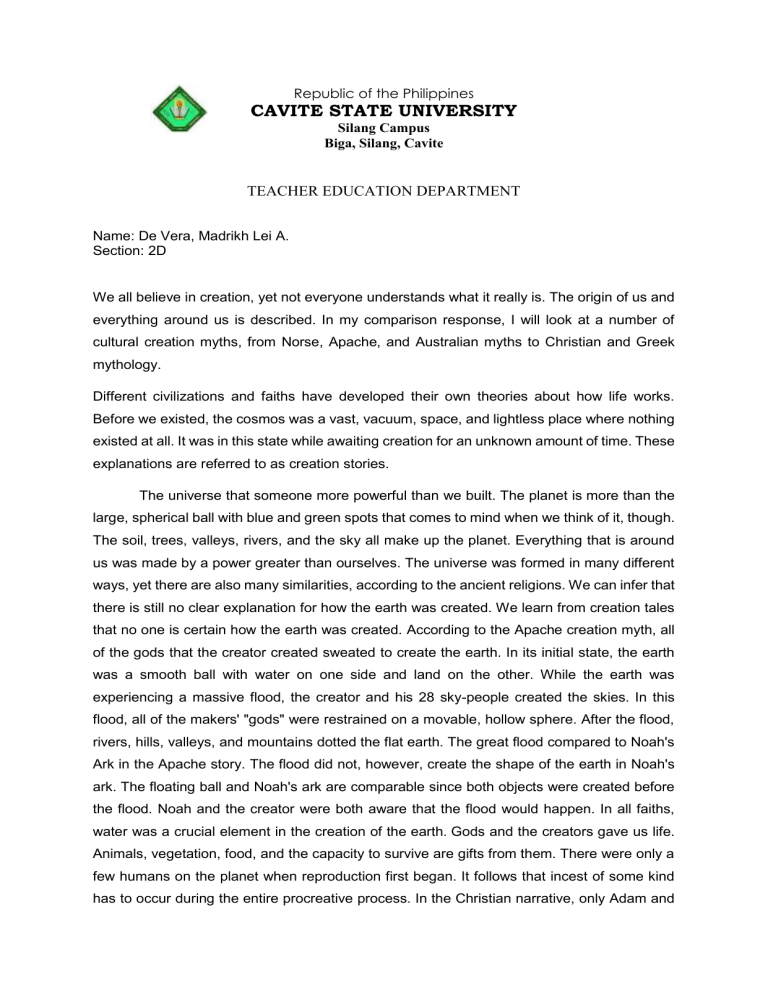
Republic of the Philippines CAVITE STATE UNIVERSITY Silang Campus Biga, Silang, Cavite TEACHER EDUCATION DEPARTMENT Name: De Vera, Madrikh Lei A. Section: 2D We all believe in creation, yet not everyone understands what it really is. The origin of us and everything around us is described. In my comparison response, I will look at a number of cultural creation myths, from Norse, Apache, and Australian myths to Christian and Greek mythology. Different civilizations and faiths have developed their own theories about how life works. Before we existed, the cosmos was a vast, vacuum, space, and lightless place where nothing existed at all. It was in this state while awaiting creation for an unknown amount of time. These explanations are referred to as creation stories. The universe that someone more powerful than we built. The planet is more than the large, spherical ball with blue and green spots that comes to mind when we think of it, though. The soil, trees, valleys, rivers, and the sky all make up the planet. Everything that is around us was made by a power greater than ourselves. The universe was formed in many different ways, yet there are also many similarities, according to the ancient religions. We can infer that there is still no clear explanation for how the earth was created. We learn from creation tales that no one is certain how the earth was created. According to the Apache creation myth, all of the gods that the creator created sweated to create the earth. In its initial state, the earth was a smooth ball with water on one side and land on the other. While the earth was experiencing a massive flood, the creator and his 28 sky-people created the skies. In this flood, all of the makers' "gods" were restrained on a movable, hollow sphere. After the flood, rivers, hills, valleys, and mountains dotted the flat earth. The great flood compared to Noah's Ark in the Apache story. The flood did not, however, create the shape of the earth in Noah's ark. The floating ball and Noah's ark are comparable since both objects were created before the flood. Noah and the creator were both aware that the flood would happen. In all faiths, water was a crucial element in the creation of the earth. Gods and the creators gave us life. Animals, vegetation, food, and the capacity to survive are gifts from them. There were only a few humans on the planet when reproduction first began. It follows that incest of some kind has to occur during the entire procreative process. In the Christian narrative, only Adam and Eve were placed on the planet. It would be impossible for Adam and Eve's offspring to conceive without engaging in incest. This increases the plausibility of the Christian religion. There are 28 persons that make up the world according to the Apache religion. resulting in a story that is more plausible. We anticipate learning about how humans and animals reproduce in these tales. People are only produced in a very different way, through dreams, in the Australian tale. For evolutionists, this is the strongest proof that evolution is true. Evolution makes more sense and is more enjoyable to consider when it comes to reproduction. Even if it doesn't exhibit incestuous behavior, it makes us wonder about the origins of the creatures from whom we emerged. The world at first was endless space in which existed only the Creator, Taiowa. This world had no time, no shape, and no life, except in the mind of the Creator. Eventually the infinite creator created the finite in Sotuknang, whom he called his nephew and whom he created as his agent to establish nine universes. Sotuknang gathered together matter from the endless space to make the nine solid worlds. Then the Creator instructed him to gather together the waters from the endless space and place them on these worlds to make land and sea. When Sotuknang had done that, the Creator instructed him to gather together air to make winds and breezes on these worlds. The fourth act of creation with which the Creator charged Sotuknang was the creation of life. Sotuknang went to the world that was to first host life and there he created Spider Woman, and he gave her the power to create life. First Spider Woman took some earth and mixed it with saliva to make two beings. Over them she sang the Creation Song, and they came to life. She instructed one of them, Poqanghoya, to go across the earth and solidify it. She instructed the other, Palongawhoya, to send out sound to resonate through the earth, so that the earth vibrated with the energy of the Creator. Poqanghoya and Palongawhoya were despatched to the poles of the earth to keep it rotating. Then Spider Woman made all the plants, the flowers, the bushes, and the trees. Likewise she made the birds and animals, again using earth and singing the Creation Song. When all this was done, she made human beings, using yellow, red, white, and black earth mixed with her saliva. Singing the Creation Song, she made four men, and then in her own form she made four women. At first they had a soft spot in their foreheads, and although it solidified, it left a space through which they could hear the voice of Sotuknang and their Creator. Because these people could not speak, Spider Woman called on Sotuknang, who gave them four languages. His only instructions were for them to respect their Creator and to live in harmony with him. These people spread across the earth and multiplied. Despite their four languages, in those days they could understand each other's thoughts anyway, and for many years they and the animals lived together as one. Eventually, however, they began to divide, both the people from the animals and the people from each other, as they focused on their differences rather than their similarities. As division and suspicion became more widespread, only a few people from each of the four groups still remembered their Creator. Sotuknang appeared before these few and told them that he and the Creator would have to destroy this world, and that these few who remembered the Creator must travel across the land, following a cloud and a star, to find refuge. These people began their treks from the places where they lived, and when they finally converged Sotuknang appeared again. He opened a huge ant mound and told these people to go down in it to live with the ants while he destroyed the world with fire, and he told them to learn from the ants while they were there. The people went down and lived with the ants, who had storerooms of food that they had gathered in the summer, as well as chambers in which the people could live. This went on for quite a while, because after Sotuknang cleansed the world with fire it took a long time for the world to cool off. As the ants' food ran low, the people refused the food, but the ants kept feeding them and only tightened their own belts, which is why ants have such tiny waists today. Finally Sotuknang was done making the second world, which was not quite as beautiful as the first. Again he admonished the people to remember their Creator as they and the ants that had hosted them spread across the earth. The people multiplied rapidly and soon covered the entire earth. They did not live with the animals, however, because the animals in this second world were wild and unfriendly. Instead the people lived in villages and built roads between these, so that trade sprang up. They stored goods and traded those for goods from elsewhere, and soon they were trading for things they did not need. As their desire to have more and more grew, they began to forget their Creator, and soon wars over resources and trade were breaking out between villages. Finally Sotuknang appeared before the few people who still remembered the Creator, and again he sent them to live with the ants while he destroyed this corrupt world. This time he ordered Poqanghoya and Palongawhoya to abandon their posts at the poles, and soon the world spun out of control and rolled over. Mountains slid and fell, and lakes and rivers splashed across the land as the earth tumbled, and finally the earth froze over into nothing but ice. This went on for years, and again the people lived with the ants. Finally Sotuknang sent Poqanghoya and Palongawhoya back to the poles to resume the normal rotation of the earth, and soon the ice melted and life returned. Sotuknang called the people up from their refuge, and he introduced them to the third world that he had made. Again he admonished the people to remember their Creator as they spread across the land. As they did so, they multiplied quickly, even more quickly than before, and soon they were living in large cities and developing into separate nations. With so many people and so many nations, soon there was war, and some of the nations made huge shields on which they could fly, and from these flying shields they attacked other cities. When Sotuknang saw all this war and destruction, he resolved to destroy this world quickly before it corrupted the few people who still remembered the Creator. He called on Spider Woman to gather those few and, along the shore, she placed each person with a little food in the hollow stem of a reed. When she had done this, Sotuknang let loose a flood that destroyed the warring cities and the world on which they lived. Once the rocking of the waves ceased, Spider Woman unsealed the reeds so the people could see. They floated on the water for many days, looking for land, until finally they drifted to an island. On the island they built little reed boats and set sail again to the east. After drifting many days, they came to a larger island, and after many more days to an even larger island. They hoped that this would be the fourth world that Sótuknang had made for them, but Spider Woman assured them that they still had a long and hard journey ahead. They walked across this island and built rafts on the far side, and set sail to the east again. They came to a fourth and still larger island, but again they had to cross it on foot and then build more rafts to continue east. From this island, Spider Woman sent them on alone, and after many days they encountered a vast land. Its shores were so high that they could not find a place to land, and only by opening the doors in their heads did they know where to go to land. When they finally got ashore, Sotuknang was there waiting for them. As they watched to the west, he made the islands that they had used like stepping stones disappear into the sea. He welcomed them to the fourth world, but he warned them that it was not as beautiful as the previous ones, and that life here would be harder, with heat and cold, and tall mountains and deep valleys. He sent them on their way to migrate across the wild new land in search of the homes for their respective clans. The clans were to migrate across the land to learn its ways, although some grew weak and stopped in the warm climates or rich lands along the way. The Hopi trekked and far and wide, and went through the cold and icy country to the north before finally settling in the arid lands between the Colorado River and Rio Grande River. They chose that place so that the hardship of their life would always remind them of their dependence on, and link to, their Creator.
